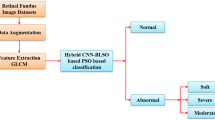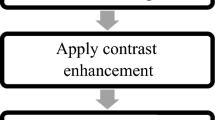Abstract
Diabetic retinopathy is the predominant cause of visual impairment in diabetes patients. The early detection process can prevent diabetes patients from severe situations. The progression of diabetic retinopathy is determined by analyzing the fundus images, thus determining whether they are affected by exudates or not. The manual detection process is laborious and requires more time and there is a possibility of wrong predictions. Therefore, this research focuses on developing an automated decision-making system. To predict the existence of exudates in fundus images, we developed a novel technique named a hybrid convolutional neural network-recurrent neural network along with the artificial humming bird optimization (HCNNRNN-AHB) approach. The proposed HCNNRNN-AHB technique effectively detects and classifies the fundus image into two categories namely exudates and non-exudates. Before the classification process, the optic discs are removed to prevent false alarms using Hough transform. Then, to differentiate the exudates and non-exudates, color and texture features are extracted from the fundus images. The classification process is then performed using the HCNNRNN-AHB approach which is the combination of CNN and RNN frameworks along with the AHB optimization algorithm. The AHB algorithm is introduced with this framework to optimize the parameters of CNN and RNN thereby enhancing the prediction accuracy of the model. Finally, the simulation results are performed to analyze the effectiveness of the proposed method using different performance metrics such as accuracy, sensitivity, specificity, F-score, and area under curve score. The analytic result reveals that the proposed HCNNRNN-AHB approach achieves a greater prediction and classification accuracy of about 97.4%.












Similar content being viewed by others
Availability of Data and Material
Data sharing is not applicable to this article as no new data were created or analyzed in this study.
Code Availability
Not applicable.
References
Auccahuasi W, Flores E, Sernaque F, Cueva J, Diaz M, Oré E: Recognition of hard exudates using Deep Learning. Procedia Computer Science. 167: 2343-2353, 2020
Bilal A, Sun G, Mazhar S, Imran A, Latif J: A Transfer Learning and U-Net-based automatic detection of diabetic retinopathy from fundus images. Computer Methods in Biomechanics and Biomedical Engineering: Imaging & Visualization. pp.1–12, 2022
Kadan AB, Subbian PS, Detection of hard exudates using evolutionary feature selection in retinal fundus images. Journal of Medical Systems, 43(7):1-12, 2019
Anitha GJ, Maria KG: Detecting hard exudates in retinal fundus images using convolutional neural networks. In 2018 International Conference on Current Trends towards Converging Technologies (ICCTCT) (pp. 1–5). IEEE, 2018
Benzamin A, Chakraborty C: Detection of hard exudates in retinal fundus images using deep learning. In 2018 Joint 7th International Conference on Informatics, Electronics & Vision (ICIEV) and 2018 2nd International Conference on Imaging, Vision & Pattern Recognition (icIVPR) (pp. 465–469). IEEE.2018
Theera-Umpon N, Poonkasem I, Auephanwiriyakul S, Patikulsila D: Hard exudate detection in retinal fundus images using supervised learning. Neural Computing and Applications, 32(17) :13079-13096, 2020
Kurilová V, Goga J, Oravec M, Pavlovičová J, Kajan S: Support vector machine and deep-learning object detection for localisation of hard exudates. Scientific Reports, 11(1) :1-9, 2021
Al Sariera TM, Rangarajan L, Amarnath R, Detection and classification of hard exudates in retinal images. Journal of Intelligent & Fuzzy Systems, 38(2):1943-1949, 2020
Long S, Huang X, Chen Z, Pardhan S, Zheng, D: Automatic detection of hard exudates in color retinal images using dynamic threshold and SVM classification: algorithm development and evaluation. BioMed research international, 2019.
Romero-Oraá R, García M, Oraá-Pérez J, López-Gálvez MI, Hornero R: Effective fundus image decomposition for the detection of red lesions and hard exudates to aid in the diagnosis of diabetic retinopathy. Sensors, 20(22):p.6549, 2020
Senthilselvi.A&Sukumar. R, “Removal of salt and pepper noise from images using Hybrid Filter (HF) and Fuzzy Logic Noise Detector (FLND)”, Concurrency and Computation: Practice and Experience, Volume 31 No 12 June 2019
Mohammed Thaha .M, Pradeepmohankumar .K Murugan .B.S, Dhanasekar .S, Vijay Karthick , P,Senthilselvi.A “Brain Tumor Segmentation Using Convolutional Neural Networks in MRI Images”,Journal of Medical Systems, Volume 43 No 9 July 2019
Senthil Pandi, Sankareswaran Mahadevan, Krishnan (2022) Unsupervised End-to-End Brain Tumor Magnetic Resonance Image Registration Using RBCNN: Rigid Transformation B-Spline Transformation and Convolutional Neural Network. Current Medical Imaging Formerly Current Medical Imaging Reviews 18(4) 387-397 https://doi.org/10.2174/1573405617666210806125526
V., Surya A., Senthilselvi (2022) Identification of oil authenticity and adulteration using deep long short-term memory-based neural network with seagull optimization algorithm. Neural Computing and Applications 34(10) 7611-7625 https://doi.org/10.1007/s00521-021-06829-3
Zong Y, Chen J, Yang L, Tao S, Aoma C, Zhao J, Wang S :U-net based method for automatic hard exudates segmentation in fundus images using inception module and residual connection. IEEE Access, 8:167225-167235, 2020
Jaya T, Dheeba J, Singh N.A: Detection of hard exudates in colour fundus images using fuzzy support vector machine-based expert system. Journal of Digital Imaging, 28(6) (2015)761–768.
Zhang W, Zhong J, Yang S, Gao Z, Hu J, Chen Y, Yi, Z: Automated identification and grading system of diabetic retinopathy using deep neural networks. Knowledge-Based Systems. 175: pp.12-25, 2019
Thomas, G. Robinson, Y.H. Julie, E.G. Shanmuganathan, V. Rho, S. Nam, Intelligent Y. prediction approach for diabetic retinopathy using deep learning based convolutional neural networks algorithm by means of retina photographs.( 2021)
Saxena G, Verma DK, Paraye A, Rajan A, Rawat A: Improved and robust deep learning agent for preliminary detection of diabetic retinopathy using public datasets. Intelligence-Based Medicine. 3: p.100022, 2020
Pao SI, Lin HZ, Chien KH, Tai MC, Chen JT, Lin GM: Detection of diabetic retinopathy using bichannel convolutional neural network. Journal of Ophthalmology 2020.
Mahmoud MH, Alamery S, Fouad H, Altinawi A, Youssef AE: An automatic detection system of diabetic retinopathy using a hybrid inductive machine learning algorithm. Personal and Ubiquitous Computing, pp.1–15, 2021
Samanta A, Saha A, Satapathy SC, Fernandes SL, Zhang YD: Automated detection of diabetic retinopathy using convolutional neural networks on a small dataset. Pattern Recognition Letters, 135: pp.293-298, 2020
Mohammed ZF, bdulla AA, An efficient CAD system for ALL cell identification from microscopic blood images. Multimedia Tools and Applications, 80(4):pp.6355–6368, 2021
Abdulla AA: Efficient computer‐aided diagnosis technique for leukemia cancer detection. IET Image Processing, 14(17):4435-4440, 2020
Gheisari S, Shariflou S, Phu J, Kennedy PJ, Agar A, Kalloniatis M, Golzan SM: A combined convolutional and recurrent neural network for enhanced glaucoma detection. Scientific reports, 11(1):pp.1–11, 2021
Jaya T, Dheeba J, Singh NA: Detection of hard exudates in colour fundus images using fuzzy support vector machine-based expert system. Journal of Digital Imaging, 28(6) 761-768, 2015
Mahesh VG, Chen C, Rajangam V, Raj ANJ, Krishnan PT: Shape and texture aware facial expression recognition using spatial pyramid Zernike moments and law’s textures feature set. IEEE Access, 9: pp.52509-52522, 2021
Kumar A, Gandhi CP, Zhou Y, Kumar R, Xiang J,: Improved deep convolution neural network (CNN) for the identification of defects in the centrifugal pump using acoustic images. Applied Acoustics, 167 : p.107399, 2020
Dong Y, Shen X, Jiang Z, Wang H: Recognition of imbalanced underwater acoustic datasets with exponentially weighted cross-entropy loss. Applied Acoustics, 174: p.107740, 2021
Amalia R, Bustamam A, Sarwinda D: Detection and description generation of diabetic retinopathy using convolutional neural network and long short-term memory. In journal of physics: conference series (Vol. 1722, No. 1, p. 012010). IOP Publishing.2021
Zhao W, Wang L, Mirjalili S: Artificial hummingbird algorithm: A new bio-inspired optimizer with its engineering applications. Computer Methods in Applied Mechanics and Engineering, 388:p.114194, 2022
Nasir JA, Khan OS, Varlamis I: Fake news detection: A hybrid CNN-RNN based deep learning approach. International Journal of Information Management Data Insights, 1(1) :p.100007, 2021
Khojasteh P, Júnior LAP ,Carvalho T, Rezende E, Aliahmad B, Papa JP, Kumar DK, Exudate detection in fundus images using deeply-learnable features. Computers in biology and medicine, 104: pp.62-69, 2019
Author information
Authors and Affiliations
Corresponding author
Ethics declarations
Ethics Approval
This article does not contain any studies with human or animal subjects performed by any of the authors.
Consent to Participate
Informed consent was obtained from all individual participants included in the study.
Consent for Publication
Not applicable.
Conflict of Interest
The authors declare no competing interests.
Additional information
Publisher's Note
Springer Nature remains neutral with regard to jurisdictional claims in published maps and institutional affiliations.
Rights and permissions
Springer Nature or its licensor holds exclusive rights to this article under a publishing agreement with the author(s) or other rightsholder(s); author self-archiving of the accepted manuscript version of this article is solely governed by the terms of such publishing agreement and applicable law.
About this article
Cite this article
E., D., S., S.P., R., P. et al. Artificial Humming Bird Optimization–Based Hybrid CNN-RNN for Accurate Exudate Classification from Fundus Images. J Digit Imaging 36, 59–72 (2023). https://doi.org/10.1007/s10278-022-00707-7
Received:
Revised:
Accepted:
Published:
Issue Date:
DOI: https://doi.org/10.1007/s10278-022-00707-7




